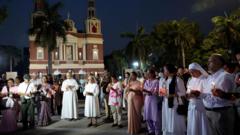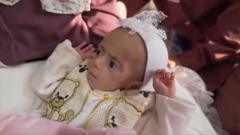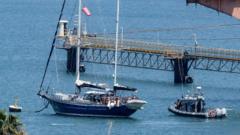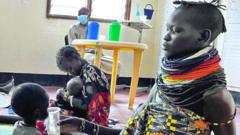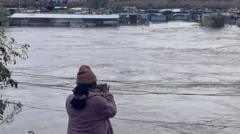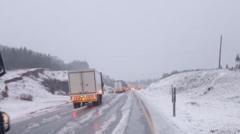As Mandalay picks up the pieces from a devastating earthquake, survivors are left waiting for assistance in the wake of severe destruction. With political turmoil complicating relief efforts, many families face despair as they seek missing loved ones amidst crumbled buildings.
Devastation in Mandalay: Earthquake Survivors Left Without Adequate Aid
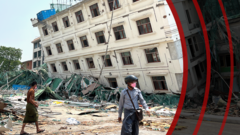
Devastation in Mandalay: Earthquake Survivors Left Without Adequate Aid
Reports reveal the overwhelming destruction caused by the recent earthquake in Mandalay, Myanmar, as survivors struggle against inadequate relief efforts.
Driving into Mandalay, the sheer devastation from last week’s earthquake became apparent, with countless collapsed buildings and cracked walls stretching across the northern and central areas of the city. The damage is so extensive that the local hospital is treating patients outdoors, indicating the severity of the crisis.
Myanmar's military regime has barred foreign journalists from entering the country post-quake, necessitating an undercover investigation to reveal what is happening on the ground. The findings reflect a heart-wrenching reality: survivors receive minimal aid amid a dire disaster zone.
Families from the collapsed structures remain hopeful, like Nan Sin Hein, who has waited nearly a week for news of her son trapped in a five-storey building that merged with the ground and tilted dangerously. As rescuers lack support, structural collapses went unaddressed, leaving victims in limbo and families desperate for recovery.
Even before the earthquake struck, Myanmar was engulfed in civil unrest and conflict, making organized relief a challenge. The military junta’s limited appeal for international aid has yielded little immediate support, and many international aid organizations fear retribution from a hostile regime. Current efforts are largely from neighboring countries such as India and China.
Rescue operations are grossly inadequate as efforts focus on vast wreckage sites including high-rise buildings like the Sky Villa and local temples where many were trapped during exams. Rescuers endure high temperatures while using rudimentary tools to sift through debris, but hope for survivors dwindles with each passing hour.
The grim reality weighs heavily on communities, as families hover at makeshift shelters, consumed by despair for loved ones still buried beneath rubble. Individuals like U Hla Aung, whose parents were found embracing in death, represent the personal tragedies unfolding amid the statistics.
Damage extends to cultural landmarks like Mandalay Palace and the Maha Muni Pagoda, compounding the city's sorrow. Amidst the fear and uncertainty of repeated aftershocks, communities are forced to sleep outdoors, and the psychological toll of trauma persists as families mourn losses.
In the weeks after the earthquake, surviving citizens like 72-year-old Daw Khin Saw Myint face overwhelming struggles for survival. Their cries for help resonate louder amid dwindling provisions. Small deliveries from local donors provide scant relief against significant and growing needs.
As the window to find survivors continues to close, the urgency for broader, more organized intervention becomes critical. The conditions at Mandalay’s hospital, now overwhelmed with casualties, are stark. With medical personnel in short supply, families scramble to assist one another amidst limited support.
Amid grief and loss, Nan Sin Hein clings to the final hope of seeing her son—alive or lifeless. Her heartbreak is a poignant reflection of an entire community grappling with unimaginable tragedies in the wake of the disaster, longing for answers and closure in a landscape marked by ruin and suffering.



